Seoul
Seoul
서울 Hanseong, Gyeongseong, Keijō | |
|---|---|
Special city | |
| Seoul Special City 서울특별시 | |
|
Namsan)[8] | |
| Mascot | Haechi |
| Tree | Ginkgo |
| Website | seoul.go.kr |
| Seoul | |
| Hangul | |
|---|---|
| Revised Romanization | Seoul |
| McCune–Reischauer | Sŏul |
| Seoul Special City | |
| Hangul | 서울특별시 |
| Hanja | |
| Revised Romanization | Seoul Teukbyeolsi |
| McCune–Reischauer | Sŏul T'ŭkpyŏlsi |
Seoul,
Seoul's history traces back to 18 BC when it was founded by the people of
Seoul was rated Asia's most livable city, with the second-highest quality of life globally according to Arcadis in 2015 and a GDP per capita (PPP) of approximately $40,000. 15 Fortune Global 500 companies, including industry giants such as Samsung,[9] LG, and Hyundai, are headquartered in the Seoul Capital Area, which has major technology hubs, such as Gangnam and Digital Media City.[10] Seoul is ranked seventh in the Global Power City Index and the Global Financial Centres Index, and is one of the five leading hosts of global conferences.[11] The city has also hosted major events such as the 1986 Asian Games, the 1988 Summer Olympics, and the 2010 G20 Seoul summit.
Seoul is geographically set in a mountainous and hilly terrain, with
Toponomy
The city has been known in the past by the names Wiryeseong (위례성; 慰禮城, during the Baekje era), Bukhansangun (북한산군; 北漢山郡 during the Goguryeo era), Namcheon (남천; 南川,[13] during the Silla era), Hanyang (한양; 漢陽, during the Northern and Southern States period), Namgyeong(남경; 南京, during Goryeo era), Hanseong (한성; 漢城, during the Joseon era), and Keijō (京城) or Gyeongseong (경성; 京城) during Japanese rule.[14]
During Japan's annexation of Korea, Hanseong (漢城) was renamed Keijō (京城) by the Imperial authorities to prevent confusion with the Hanja '漢' (a transliteration of an ancient Korean word Han (한) meaning "great"), which also refers to Han people or the Han dynasty in Chinese and in Japanese is a term for "China".[15]
After World War II and the liberation of Korea, the city took its present name, which originated from the Korean word meaning "capital city", which is believed to have descended from an ancient word, Seorabeol (서라벌; 徐羅伐), which originally referred to Gyeongju, the capital of Silla.[16] Ancient Gyeongju was also known in documents by the Chinese-style name Geumseong (金城, literally "Gold Castle or City" or "Metal Castle or City"), but it is unclear whether the native Korean-style name Seorabeol had the same meaning as Geumseong.[citation needed]
Unlike most place names in Korea, "Seoul" has no corresponding Hanja (Chinese characters used in the Korean language). On 18 January 2005, the Seoul government changed its official name in Chinese characters from the historic Hancheng (simplified Chinese: 汉城; traditional Chinese: 漢城; pinyin: Hànchéng) to Shou'er (首尔; 首爾; Shǒu'ěr).[17][18]
History
Early history
Settlement of the Han River area, where present-day Seoul is located, began around 4000 BC.[19]
Seoul is first recorded as Wiryeseong, the capital of Baekje (founded in 18 BC) in the northeastern area of modern Seoul.[19] There are several city walls remaining in the area that date from this time. Pungnaptoseong, an earthen wall located southeast Seoul, is widely believed to have been at the main Wiryeseong site.[20] As the Three Kingdoms competed for this strategic region, control passed from Baekje to Goguryeo in the 5th century.[21]
However, according to Samguk Sagi, both Baekje and Silla described the land as frontier border of Baekje, not as the capital region.[22][23] Moreover, Jinheung Taewang Stele found at current day Bukhansan tells that the place was underdeveloped as of 6th century AD,[13] suggesting that the first capital Wiryeseong was not located in or nearby Seoul.
In July or August 553, Silla took the control of the region from Baekje, and the city became a part of newly established Sin Province (신주; 新州).[22][23] Sin (新) has both meaning of "New" and "Silla", thus literally means New Silla Province.
In November 555, Jinheung Taewang made royal visit to Bukhansan, and inspected the borderline.[24] In 557, Silla abolished Sin Province, and established Bukhansan Province (북한산주; 北漢山州).[25] The word Hanseong (한성; 漢城; lit. Han Fortress) appears on the stone wall of "Pyongyang Fortress", which was presumably built in the mid to late 6th century AD over period of 42 years, located in Pyongyang, while there is no evidence that Seoul had name Hanseong dating the three kingdoms and earlier period.[26][27][28][29][30]
In 568, Jinheung Taewang made another royal visit to the northern border, visited Hanseong, and stayed in Namcheon on his way back to the capital. During his stay, he set Jinheung Taewang Stele, abolished Bukhansan Province, and established Namcheon Province (남천주; 南川州; South River Province), appointing the city as the provincial capital.[13][31] Based on the naming system, the actual name of Han River during this time was likely Namcheon (Nam River) itself or should have the word ending with "cheon" (천; 川) not "gang" (강; 江) nor "su" (수; 水). In addition, "Bukhansan" Jinheung Stele clearly states that Silla had possession of Hanseong (modern day Pyongyang), thus Bukhansan has to be located north of Hanseong. Modern day Pyongyang was not Pyongyang, Taedong River was likely Han River, and Bukhansan was not Bukhansan during the three kingdoms period.[13][32] Moreover, Pyongyang was a common noun meaning capital used by Goguryeo and Goryeo dynasties, similar to Seoul.[33]
In 603, Goguryeo attacked Bukhansanseong (북한산성; 北漢山城; Bukhan Mountain Fortress), which Silla ended up winning.[34][35] In 604, Silla abolished Namcheon Province, and reestablished Bukhansan Province in order to strengthen the northern border. The city lost its provincial capital position and was put under Bukhansan Province once again.[36] This further proves that Bukhansan was located in the North of modern-day Pyongyang as changing the provincial name and objective would not be required if Bukhansan was located within Seoul.
In the 11th century Goryeo, which succeeded Unified Silla, built a summer palace in Seoul, which was referred to as the "Southern Capital". It was only from this period that Seoul became a larger settlement.[19]
Joseon dynasty
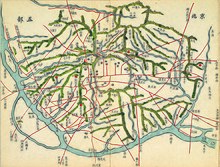
Seoul was
The city of Hanyang was governed by Hanseongbu (한성부), an agency of the national government dedicated to affairs on administration of capital city. Hanseongbu divided the Hanyang city into two major category; Areas inside the Fortress Wall, and areas 10 Ri (Korean mile) around the Fortress Wall. Former areas were typically named as Seong-jung (성중; 城中) or Doseong-an (도성 안; lit. Inside the fortress) and latters were named as Seongjeosimni (Korean: 성저십리; Hanja: 城底十里; lit. 10 Ris around the fortress). The Doseong-an area later gained informal but popular name Sadaemun-an (사대문 안), which literally means 'areas inside of the Four Great Gates', and became the one and only downtown (city center) of Hanyang city.[38]: 90–100
In the late 19th century, after hundreds of years of isolation, Seoul opened its gates to foreigners and began to modernize. Seoul became the first city in East Asia to introduce electricity in the royal palace, built by the Edison Illuminating Company[39] and a decade later Seoul also implemented electrical street lights.[40]
Korean Empire

After
In 1904, an American by the name of Angus Hamilton visited the city and said, "The streets of Seoul are magnificent, spacious, clean, admirably made and well-drained. The narrow, dirty lanes have been widened, gutters have been covered, roadways broadened. Seoul is within measurable distance of becoming the highest, most interesting and cleanest city in the East."[42]
Japanese annexation of Korea

After the
Seoul was deprived of its special status as the capital city and downsized under imperial Japan, compared to the traditional notion among people of the
The city was liberated by U.S. forces at the end of World War II.
Contemporary history
In 1945, following the liberation from Japanese colonial rule, the American military assumed control of Korea, including its capital city, then referred to as Kyeongseongbu in line with Japanese nomenclature. The
The City of Seoul is hereby constituted a municipal corporation to be known as SEOUL. The boundaries of the municipal corporation are the present limits of the City of Seoul consisting of the following eight districts: Chong Koo, Chong No Koo, Sur Tai Moon Koo, Tong Tai Moon Koo, Sung Tong Koo, Ma Po Koo, Yong San Koo, and Yang Doung Po Koo, and as such may be extended as provided by law.
— U.S. Army Military Government in Korea, Charter of the City of Seoul
Seoul under the U.S. military government between 1945 and 1948 was much smaller than it is today. It only covered the
During the Korean War, Seoul changed hands between the Soviet/Chinese-backed North Korean forces and the American-backed South Korean forces four times: falling to the North Koreans in the June 1950 First Battle of Seoul, recaptured by UN forces in the September 1950 Second Battle of Seoul, falling to a combined Chinese/North Korean force in the January 1951 Third Battle of Seoul, and finally being recaptured once more by UN forces in Operation Ripper during the spring of 1951.[45][46] The extensive fighting left the city heavily damaged after the war. The capital was temporarily relocated to Busan.[19] One estimate of the extensive damage states that after the war, at least 191,000 buildings, 55,000 houses, and 1,000 factories lay in ruins. In addition, a flood of refugees had entered Seoul during the war, swelling the population of the city and its metropolitan area to an estimated 1.5 million by 1955.[47]
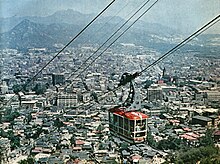
Following the war, Seoul began to focus on reconstruction and modernization. As
After annexation, Gangnam's development was spurred by key infrastructure projects: the construction of the Hannam Bridge (1966–1969) and Gyeongbu Expressway (1968–1970). As Seoul's population kept growing, Park's regime focused its development plans on Gangnam. The main hurdle for Gangnam's development was floods because the area is low-lying and prone to flooding. Then Seoul mayor Kim Hyun-ok ordered construction of an expressway that doubled as embankment, which became the present-day Gangbyeon Expressway. The construction started in March 1967 and completed in September of the same year. Similar projects transformed previously flood-prone areas into usable land for development. Such areas include the current Ichon-dong, the Banpo apartment complex, Apgujeong-dong and Jamsil-dong.
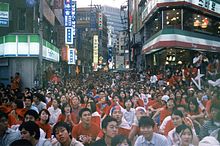
Until 1972, Seoul was claimed by North Korea as its de jure capital, being specified as such in Article 103 of the 1948 North Korean constitution.[51]
Seoul was the host city of the 1986 Asian Games and 1988 Summer Olympics as well as one of the venues of the 2002 FIFA World Cup.
Geography
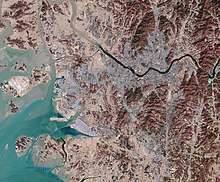
Seoul is in the northwest of South Korea. Seoul proper comprises 605.25 km2 (233.69 sq mi),
Parks
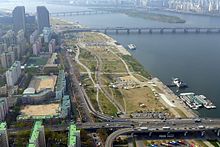
Seoul has a large quantity of parks. One of the most famous parks is
There are also many parks along the Han River, such as Ichon Hangang Park, Yeouido Hangang Park, Mangwon Hangang Park, Nanji Hangang Park, Banpo Hangang Park, Ttukseom Hangang Park and Jamsil Hangang Park. The Seoul National Capital Area also contains a green belt aimed at preventing the city from sprawling out into neighboring Gyeonggi Province. These areas are frequently sought after by people looking to escape from urban life on weekends and during vacations.
Air quality
Since the early 1960s, the
Climate
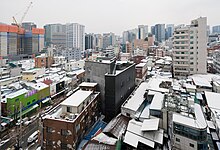
Seoul has a
| Climate data for Seoul (1991–2020 normals, extremes 1907–present) | |||||||||||||
|---|---|---|---|---|---|---|---|---|---|---|---|---|---|
| Month | Jan | Feb | Mar | Apr | May | Jun | Jul | Aug | Sep | Oct | Nov | Dec | Year |
| Record high °C (°F) | 14.4 (57.9) |
18.7 (65.7) |
25.1 (77.2) |
29.8 (85.6) |
34.4 (93.9) |
37.2 (99.0) |
38.4 (101.1) |
39.6 (103.3) |
35.1 (95.2) |
30.1 (86.2) |
25.9 (78.6) |
17.7 (63.9) |
39.6 (103.3) |
| Mean daily maximum °C (°F) | 2.1 (35.8) |
5.1 (41.2) |
11.0 (51.8) |
17.9 (64.2) |
23.6 (74.5) |
27.6 (81.7) |
29.0 (84.2) |
30.0 (86.0) |
26.2 (79.2) |
20.2 (68.4) |
11.9 (53.4) |
4.2 (39.6) |
17.4 (63.3) |
| Daily mean °C (°F) | −2.0 (28.4) |
0.7 (33.3) |
6.1 (43.0) |
12.6 (54.7) |
18.2 (64.8) |
22.7 (72.9) |
25.3 (77.5) |
26.1 (79.0) |
21.7 (71.1) |
15.0 (59.0) |
7.5 (45.5) |
0.2 (32.4) |
12.8 (55.0) |
| Mean daily minimum °C (°F) | −5.5 (22.1) |
−3.2 (26.2) |
1.9 (35.4) |
8.0 (46.4) |
13.5 (56.3) |
18.7 (65.7) |
22.3 (72.1) |
22.9 (73.2) |
17.7 (63.9) |
10.6 (51.1) |
3.5 (38.3) |
−3.4 (25.9) |
8.9 (48.0) |
| Record low °C (°F) | −22.5 (−8.5) |
−19.6 (−3.3) |
−14.1 (6.6) |
−4.3 (24.3) |
2.4 (36.3) |
8.8 (47.8) |
12.9 (55.2) |
13.5 (56.3) |
3.2 (37.8) |
−5.1 (22.8) |
−11.9 (10.6) |
−23.1 (−9.6) |
−23.1 (−9.6) |
| Average precipitation mm (inches) | 16.8 (0.66) |
28.2 (1.11) |
36.9 (1.45) |
72.9 (2.87) |
103.6 (4.08) |
129.5 (5.10) |
414.4 (16.31) |
348.2 (13.71) |
141.5 (5.57) |
52.2 (2.06) |
51.1 (2.01) |
22.6 (0.89) |
1,417.9 (55.82) |
| Average precipitation days (≥ 0.1 mm) | 6.1 | 5.8 | 7.0 | 8.4 | 8.6 | 9.9 | 16.3 | 14.7 | 9.1 | 6.1 | 8.8 | 7.8 | 108.6 |
| Average snowy days | 7.1 | 5.1 | 2.8 | 0.2 | 0.0 | 0.0 | 0.0 | 0.0 | 0.0 | 0.0 | 2.3 | 6.4 | 23.9 |
| Average relative humidity (%)
|
56.2 | 54.6 | 54.6 | 54.8 | 59.7 | 65.7 | 76.2 | 73.5 | 66.4 | 61.8 | 60.4 | 57.8 | 61.8 |
| Mean monthly sunshine hours | 169.6 | 170.8 | 198.2 | 206.3 | 223.0 | 189.1 | 123.6 | 156.1 | 179.7 | 206.5 | 157.3 | 162.9 | 2,143.1 |
| Percent possible sunshine | 52.3 | 53.6 | 51.0 | 51.9 | 48.4 | 41.2 | 26.8 | 36.2 | 47.2 | 57.1 | 50.2 | 51.1 | 46.4 |
| Average ultraviolet index | 2 | 3 | 5 | 7 | 8 | 9 | 10 | 9 | 7 | 4 | 3 | 2 | 6 |
| Source 1: Korea Meteorological Administration (percent sunshine 1981–2010)[70][71][72] | |||||||||||||
| Source 2: Weather Atlas (UV),[73] Meteo Climat (record highs and lows)[74] | |||||||||||||
Government

The Seoul Metropolitan Government is the local government for Seoul, and is responsible for the administration and provision of various services to the city, including correctional institutions, education, libraries, public safety, recreational facilities, sanitation, water supply, and welfare services. It is headed by a mayor and three vice mayors, and is divided into 25 autonomous districts and 522 administrative neighborhoods.[75][76]
Administrative districts
Seoul is divided into 25
Demographics
| Year | Pop. | ±% p.a. |
|---|---|---|
| 1950 | 1,021,000 | — |
| 1960 | 2,361,000 | +8.74% |
| 1970 | 5,312,000 | +8.45% |
| 1980 | 8,244,000 | +4.49% |
| 1990 | 10,518,000 | +2.47% |
| 2000 | 9,879,000 | −0.62% |
| 2010 | 9,796,000 | −0.08% |
| 2020 | 9,963,000 | +0.17% |
| source:[78] | ||
Seoul proper is noted for its population density, which is almost twice that of New York City and eight times greater than Rome. Its metropolitan area was the most densely populated among OECD countries in Asia in 2012, and second worldwide after that of Paris.[79] As of 2015, the population was 9.86 million,[80] in 2012, it was 10.44 million. As of 2021, the population is 9.59 million.[81][82] As of the end of June 2011, 10.29 million Republic of Korea citizens lived in the city. This was a 0.24% decrease from the end of 2010. The population of Seoul has been dropping since the early 1990s, the reasons being the high costs of living, urban sprawling to Gyeonggi region's satellite bed cities and an aging population.[80]
As of 2016, the number of foreigners living in Seoul was 404,037, 22.9% of the total foreign population in South Korea.
Religion
The two major religions in Seoul are
Education

Compulsory education lasts from grade 1–9 (six years of elementary school and three years of middle school).[88] Students spend six years in elementary school, three years in middle school, and three years in high school. Secondary schools generally require students to wear uniforms. There is an exit exam for graduating from high school and many students proceeding to the university level are required to take the College Scholastic Ability Test that is held every November. Although there is a test for non-high school graduates, called school qualification exam, most Koreans take the test.
Seoul is home to various
Seoul is home to the majority of South Korea's most prestigious universities, including Seoul National University, Yonsei University, Korea University. Seoul ranked 2nd on the QS Best Student Cities 2023.[89]
Economy

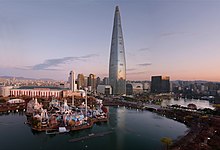


Seoul is the business and financial hub of South Korea. Although it accounts for only 0.6 percent of the nation's land area, 48.3 percent of South Korea's bank deposits were held in Seoul in 2003,
Manufacturing
The traditional, labor-intensive manufacturing industries have been continuously replaced by
Business and finance

According to the Global Financial Centerss Index report released in 2024, Seoul ranked 10th. The city ranked 13th in business environment and financial sector development, seventh in human capital, 10th in infrastructure and 12th in reputation.[99]
Seoul has three
In 2023, the city announced plans to invest $44.7 million over six years to create a dedicated area to attract foreign investment.[99]
Commerce
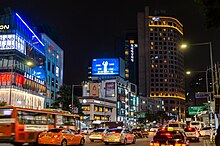
The largest wholesale and retail market in South Korea, the
The
Korea World Trade Center Complex, which comprises COEX mall, congress center, 3 Inter-continental hotels, Business tower (Asem tower), Residence hotel, Casino and City airport terminal was established in 1988 in time for the
Technology
Seoul has been described as the world's "most wired city",[112] ranked first in technology readiness by PwC's Cities of Opportunity report.[113] Seoul has a very technologically advanced infrastructure.[114][115]
Seoul is among the world leaders in Internet connectivity, being the capital of South Korea, which has the world's highest
Culture
Architecture
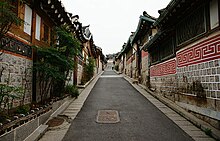
The traditional heart of Seoul is the old Joseon dynasty city, now the downtown area, where most palaces, government offices, corporate headquarters, hotels, and traditional markets are located. Cheonggyecheon, a stream that runs from west to east through the valley before emptying into the Han River, was for many years covered with concrete, but was recently restored by an urban revival project in 2005.[120] Jongno street, meaning "Bell Street", has been a principal street and one of the earliest commercial streets of the city,[121][122] on which one can find Bosingak, a pavilion containing a large bell.
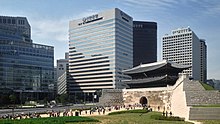
Seoul has many historical and cultural landmarks. In Amsa-dong Prehistoric Settlement Site, Gangdong District, neolithic remains were excavated and accidentally discovered by a flood in 1925.[123]
Urban and civil planning was a key concept when Seoul was first designed to serve as a capital in the late 14th century. The Joseon dynasty built the "Five Grand Palaces" in Seoul—
Museums
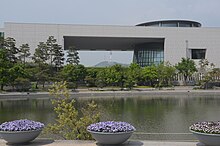
Seoul is home to 115 museums,[126] including four national and nine official municipal museums. The National Museum of Korea has a collection of 220,000 artifacts.[127] The National Folk Museum is located on the grounds of Gyeongbokgung and focuses on the daily life of historical Koreans.[128] Bukchon Hanok Village and Namsangol Hanok Village are old residential districts consisting of hanok (traditional Korean houses).[129][130]
The War Memorial covers the history of wars that Korea has been involved with, especially the Korean War.[131][132] Seodaemun Prison is a former prison built during the Japanese occupation, and is used as a historic museum.[133] The Seoul Museum of Art, Leeum, Samsung Museum of Art, and Ilmin Museum of Art are art museums in the city.
Festivals

In October 2012,
Media

Seoul is home of the major South Korean networks
Sports

Seoul is a major center of
Seoul hosted the
Transportation
Seoul has a well developed transportation network. Its system dates back to the era of the
Bus

Seoul's bus system is operated by the Seoul Metropolitan Government (S.M.G.), with four primary bus configurations available servicing most of the city. Seoul has many large intercity/express bus terminals. These buses connect Seoul with cities throughout South Korea. The Seoul Express Bus Terminal, Central City Terminal and Seoul Nambu Terminal are located in the district of Seocho District. In addition, East Seoul Bus Terminal in Gwangjin District and Sangbong Terminal in Jungnang District handles traffics mainly from Gangwon and Chungcheong provinces.
Urban rail
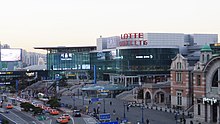
Seoul has a comprehensive
Train
Seoul is connected to every major city in South Korea by rail. Most major South Korean cities are linked via the KTX high-speed train, which has a normal operation speed of more than 300 km/h (186 mph). The Mugunghwa and Saemaeul trains also stop at all major stations. Major railroad stations include:[citation needed]
- )
- Yongsan station, Yongsan District: Honam line (KTX/ITX-Saemaeul/Nuriro/Mugunghwa), Jeolla/Janghang lines (Saemaul/Mugunghwa)
- Yeongdeungpo station, Yeongdeungpo District: Gyeongbu/Honam/Janghang lines (KTX/ITX-Saemaeul/Saemaul/Nuriro/Mugunghwa)
- Cheongnyangni station, Dongdaemun District: Gyeongchun/Jungang/Yeongdong/Taebaek lines (ITX-Cheongchun/ITX-Saemaeul/Mugunghwa)
- Suseo HSR(SRT)
Airports
Seoul is served by two international airports, Incheon International Airport and Gimpo International Airport.
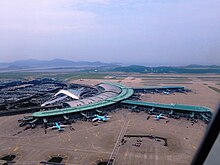
Incheon and Gimpo are linked to Seoul by
Cycling
Cycling is becoming increasingly popular in Seoul and in the entire country. Both banks of the Han River have cycling paths that run all the way across the city along the river. In addition, Seoul introduced in 2015 a bicycle-sharing system named Ddareungi (and named Seoul Bike in English).[141]
International relations
Seoul is a member of the Asian Network of Major Cities 21 and the C40 Cities Climate Leadership Group. In addition, Seoul hosts many embassies of countries it has diplomatic ties with.
Sister cities
See also
- Geography of South Korea
- List of cities in South Korea
- List of most populous cities
- List of tallest buildings in Seoul
- Economy of Seoul
Notes
References
- ^ ""Seoul, my soul" selected as the city's new slogan". Seoul Metropolitan Government. 5 April 2023. Archived from the original on 7 May 2023. Retrieved 11 May 2023.
- ^ "서울시 사이트에 서울 시가인 서울의 찬가가 없습니다". Seoul Metropolitan Government. Archived from the original on 22 September 2021. Retrieved 22 September 2021.
- ^ a b "Seoul Statistics (Land Area)". Seoul Metropolitan Government. Archived from the original on 19 October 2013. Retrieved 24 March 2010.
- ^ Seoul Capital Area
- ^ "City Overview (Population)". Seoul Metropolitan Government. Archived from the original on 26 November 2021. Retrieved 26 November 2021.
- ^ "2022년 지역소득(잠정)". www.kostat.go.kr.
- ^ "Color". Archived from the original on 11 May 2012. Retrieved 8 April 2012.
- ^ "Seoul's symbols". Seoul Metropolitan Government. Archived from the original on 19 August 2016. Retrieved 3 August 2016.
- ^ "Samsung Electronics". Fortune. Archived from the original on 24 October 2014. Retrieved 24 October 2014.
- ^ "Tech capitals of the world". The Age. Melbourne. 15 June 2009. Archived from the original on 12 September 2009. Retrieved 7 August 2013.
- ^ Union of International Associations (UIA) International Meetings Statistics for the Year 2011 Archived 3 July 2014 at the Wayback Machine. Joel Fischer.
- ^ "Lists: Republic of Korea". UNESCO. Archived from the original on 25 December 2019. Retrieved 26 December 2019.
- ^ a b c d "Monument on Bukhansan Mountain Commemorating the Border Inspection by King Jinheung of Silla". National Institute of Korean History. Archived from the original on 22 January 2023. Retrieved 22 January 2023.
- Kyŏngsŏng(Gyeongseong), respectively.
- ISBN 9781474421829. Archivedfrom the original on 14 July 2022. Retrieved 21 November 2020.
- ^ "Yahoo holiday travel guide". Uk.holidaysguide.yahoo.com. Archived from the original on 7 January 2007.
- Naver News. 23 October 2005. Archivedfrom the original on 25 January 2016. Retrieved 10 February 2012.
- ^ Characters, Good. "Chinese Naming Crisis Danger Opportunity Summer 2006 – Good Characters". goodcharacters.com. Archived from the original on 30 September 2018. Retrieved 18 November 2018.
- ^ a b c d e "Seoul". Encyclopædia Britannica. Archived from the original on 22 February 2014. Retrieved 7 February 2014.
- ^ a b "Pungnap-toseong (Earthen Ramparts)". Seoul Metropolitan Government. Archived from the original on 22 February 2014. Retrieved 7 February 2014.
- ISBN 9781136166983. Archivedfrom the original on 10 October 2020.
- ^ a b "Samguk Sagi Silla Jinheung 19". National Institute of Korean History. Archived from the original on 22 January 2023. Retrieved 22 January 2023.
- ^ a b "Samguk Sagi Baekje Seong 19". National Institute of Korean History. Archived from the original on 22 January 2023. Retrieved 22 January 2023.
- ^ "Samguk Sagi Silla Jinheung 24". National Institute of Korean History. Archived from the original on 22 January 2023. Retrieved 22 January 2023.
- ^ "Samguk Sagi Silla Jinheung 28". National Institute of Korean History. Archived from the original on 22 January 2023. Retrieved 22 January 2023.
- ^ "Pyongyang Fortress Stone 1". National Institute of Korean History. Archived from the original on 22 January 2023. Retrieved 22 January 2023.
- ^ "Pyongyang Fortress Stone 2". National Institute of Korean History. Archived from the original on 22 January 2023. Retrieved 22 January 2023.
- ^ "Pyongyang Fortress Stone 3". National Institute of Korean History. Archived from the original on 22 January 2023. Retrieved 22 January 2023.
- ^ "Pyongyang Fortress Stone 4". National Institute of Korean History. Archived from the original on 22 January 2023. Retrieved 22 January 2023.
- ^ "Pyongyang Fortress Stone 6". National Institute of Korean History. Archived from the original on 22 January 2023. Retrieved 22 January 2023.
- ^ "Samguk Sagi Silla Jinheung 45". National Institute of Korean History. Archived from the original on 22 January 2023. Retrieved 22 January 2023.
- ^ ""고구려 수도 평양은 북한땅에 없었다"". 신동아 (in Korean). 22 January 2013. Archived from the original on 22 January 2023. Retrieved 22 January 2023.
- ^ "고대 평양은 지금의 평양이 아니다". K스피릿 (in Korean). 11 July 2016. Archived from the original on 22 January 2023. Retrieved 22 January 2023.
- ^ "Samguk Sagi Silla Jinpyeong 30". National Institute of Korean History. Archived from the original on 22 January 2023. Retrieved 22 January 2023.
- ^ "Samguk Sagi Goguryeo Yeongyang 15". National Institute of Korean History. Archived from the original on 22 January 2023. Retrieved 22 January 2023.
- ^ "Samguk Sagi Silla Jinpyeong 32". National Institute of Korean History. Archived from the original on 22 January 2023. Retrieved 22 January 2023.
- ISBN 9791160711301.
- ISBN 9791160710670.
- ^ Nam Moon Hyon. "Early History of Electrical Engineering in Korea: Edison and First Electric Lighting in the Kingdom of Corea" (PDF). Promoting the History of EE Jan 23–26, 2000. Institute of Electrical and Electronics Engineers. Archived (PDF) from the original on 22 February 2014. Retrieved 7 February 2014.
- ISBN 9780230364523. Archivedfrom the original on 25 January 2016. Retrieved 9 November 2015.
- ISBN 9780198039662.
- ISBN 9780393347531. Archivedfrom the original on 30 September 2022. Retrieved 21 November 2020.
- ^ "서울은 어떻게 '특별시'가 됐나…근거 문서 '서울시헌장' 공개". history.seoul.go.kr. Seoul Historiography Institute.
- Yeongdeungpo-guwas incorporated into Kyeongseong (or Keijō) and developed under imperial Japan as a major industrial complex.
- ^ "The Korean War Chronology". U.S. Army Center of Military History. Archived from the original on 9 September 2023. Retrieved 6 September 2023.
- ^ "Chapter XXVI: The Capture of Seoul". U.S. Army Center of Military History. Archived from the original on 7 February 2023. Retrieved 6 September 2023.
- ^ ISBN 9781136639272. Archivedfrom the original on 25 January 2016. Retrieved 9 November 2015.
- ^ "서울의 역사". Seoul Metropolitan Government (in Korean).
- ^ "Urban Planning of Seoul" (PDF). Seoul Metropolitan Government. 2009. Archived from the original on 25 January 2016. Retrieved 7 February 2014.
- ^ "면적과 인구밀도". data.si.re.kr. 서울연구데이터서비스.
- ^ "Constitution of the Democratic People's Republic of Korea" (PDF). Archived from the original (PDF) on 14 September 2016. Retrieved 20 January 2017.
- ^ "Korean Cultural Centre India New Delhi". Korean Cultural Centre India New Delhi. Archived from the original on 20 July 2020. Retrieved 31 October 2021.
- ^ "GLOBAL 500". CNNMoney. 23 July 2012. Archived from the original on 19 November 2018. Retrieved 7 February 2014.
- ^ Lee, Hyun-jeong. "Korea Wrestles with Growing Health Threat from Fined Dust" Archived 9 April 2017 at the Wayback Machine. Korea Herald. 23 March 2015. Retrieved 8 April 2017.
- ^ a b Hu, Elise. "Korea's Air Is Dirty, But It's Not All Close-Neighbor China's Fault" Archived 9 August 2018 at the Wayback Machine. NPR. 3 June 2016. Retrieved 8 April 2017.
- ^ "Seoul's smelly gingko problem". BBC News. 12 October 2015. Archived from the original on 17 February 2019. Retrieved 16 February 2019.
- ^ "[Feature] South Korea's odor pollution problem". 3 October 2018. Archived from the original on 17 February 2019. Retrieved 16 February 2019.
- ^ a b Global Urban Ambient Air Pollution Database. Archived 19 April 2019 at the Wayback Machine World Health Organization. May 2016. Retrieved 8 April 2017.
- ^ a b WHO Air Quality Guidelines. Archived 23 April 2018 at the Wayback Machine World Health Organization. September 2016. Retrieved 8 April 2017.
- ^ Air Quality Information. Archived 10 April 2017 at the Wayback Machine Seoul Metropolitan Government. Retrieved 8 April 2017.
- ^ Yu-Jin Choi; Woon-Soo Kim (25 June 2015). "Changes in Seoul's Air Quality Control Policy". Seoul Solution. Archived from the original on 6 September 2017. Retrieved 12 April 2017.
- ^ 1st Seoul Metropolitan Air Quality Improvement Plan. Archived 27 April 2017 at the Wayback Machine Ministry of Environment, Republic of Korea. Retrieved 21 April 2017.
- PMID 26079317.
- ^ 2nd Seoul Metropolitan Air Quality Improvement Plan. Archived 26 April 2017 at the Wayback Machine Ministry of Environment, Republic of Korea. Retrieved 21 April 2017.
- ^ Chung, Anna. "Korea's policy towards pollution and fine particle: a sense of urgency" Archived 27 April 2017 at the Wayback Machine. Korea Analysis. v2. June 2014. Retrieved 21 April 2017.
- S2CID 202176909.
- ^ "Seoul, South Korea Köppen Climate Classification (Weatherbase)". Weatherbase. Archived from the original on 10 October 2020. Retrieved 9 June 2019.
- ^ Peterson, Adam (31 October 2018), English: Data sources: Köppen types calculated from data from WorldClim.org, archived from the original on 10 October 2020, retrieved 9 June 2019
- from the original on 10 October 2020. Retrieved 18 November 2018.
- ^ "Climatological Normals of Korea (1991 ~ 2020)" (PDF) (in Korean). Korea Meteorological Administration. Archived from the original (PDF) on 29 January 2022. Retrieved 31 January 2022.
- ^ 순위값 - 구역별조회 (in Korean). Korea Meteorological Administration. Retrieved 2 October 2021.
- ^ "Climatological Normals of Korea" (PDF). Korea Meteorological Administration. 2011. p. 499 and 649. Archived from the original (PDF) on 7 December 2016. Retrieved 8 December 2016.
- ^ "Seoul, South Korea - Detailed climate information and monthly weather forecast". Weather Atlas. Yu Media Group. Retrieved 9 July 2019.
- ^ "Station Seoul" (in French). Meteo Climat. Retrieved 10 October 2018.
- ^ "서울특별시청 Seoul Metropolitan Government" (in Korean). Doosan Encyclopedia. Archived from the original on 22 January 2013. Retrieved 7 May 2008.
- ^ "Organization Chart". Official site of Seoul Metropolitan Government. Archived from the original on 8 May 2008. Retrieved 7 May 2008.
- ^ a b "Administrative Districts". Seoul Metropolitan Government. Archived from the original on 10 August 2011. Retrieved 8 February 2014.
- ^ "World Urbanization Prospects". Archived from the original on 19 January 2020. Retrieved 20 February 2020.
- from the original on 21 February 2014. Retrieved 11 February 2014.
- ^ a b "Seoul's Population Drops Below 10 Million for First Time in 25 Years". The Chosun Ilbo. 14 February 2014. Archived from the original on 4 March 2014. Retrieved 16 February 2014.
- ^ "32년 만에 '1000만 서울 시대' 막 내렸다..." Hankook Ilbo (in Korean). 3 March 2021. Archived from the original on 17 April 2021. Retrieved 17 April 2021.
- ^ "Seoul Statistics (Population)". Seoul Metropolitan Government. Archived from the original on 19 October 2013. Retrieved 3 March 2013.
- ^ "1.76 million foreigners live in South Korea; 3.4% of population". 17 November 2017. Archived from the original on 21 December 2017. Retrieved 20 December 2017.
- ^ "Korean Chinese account for nearly 70% of foreigners in Seoul". The Korea Times. 11 September 2011. Archived from the original on 19 January 2012. Retrieved 11 February 2014.
- ^ "South Korean mega-churches. For God and country". Economist. 15 October 2011. Archived from the original on 15 January 2018. Retrieved 11 February 2014.
- ^ "2015 Census – Religion Results" (in Korean). KOSIS KOrean Statistical Information Service. Archived from the original on 26 February 2021. Retrieved 10 March 2021.
- ^ "Dongguk University". Archived from the original on 15 September 2018.
- ^ 의무교육(무상의무교육). Archived from the original on 10 October 2020. Retrieved 13 October 2017.
- ^ "QS Best Student Cities 2023". Quacquarelli Symonds Limited. 29 June 2022. Archived from the original on 7 July 2022. Retrieved 20 July 2022.
- ^ Yim, Seok-hui. "Geographical Features of Social Polarization in Seoul, South Korea" (PDF). In Mizuuchi, Toshio (ed.). Representing Local Places and Raising Voices from Below. Osaka City University. p. 34. Archived (PDF) from the original on 23 April 2016. Retrieved 19 April 2016.
- ISBN 9789264173897.
- MasterCard. Archived from the original(PDF) on 24 June 2008. Retrieved 13 February 2014.
- ^ "The Global Financial Centres Index 12" (PDF). Z/Yen Group. 2012. Archived from the original (PDF) on 23 March 2014. Retrieved 11 February 2014.
- The Economist Intelligence Unit. 2013. Archived(PDF) from the original on 9 January 2014. Retrieved 13 February 2014.
- ^ a b "Seoul: Economy". Encyclopædia Britannica. Archived from the original on 22 February 2014. Retrieved 13 February 2014.
- ^ "The primacy of Seoul and the capital region". United Nations University. Archived from the original on 4 November 2014. Retrieved 13 February 2014.
- ^ "It's official: Jinro soju is the world's best-selling liquor". CNNTravel. 12 June 2012. Archived from the original on 21 February 2014. Retrieved 29 April 2013.
- ^ "Fiery food, boring beer". The Economist. 24 November 2012. Archived from the original on 1 July 2017. Retrieved 24 April 2013.
- ^ a b "Seoul rises one spot to 10th in Global Financial Centres Index". The Korea Herald. 21 March 2024.
- ^ "Top 3 Major Business Districts (CBD) in Seoul, Korea". pearsonkorea.com. Pearson & Partners. 25 August 2020. Retrieved 5 March 2024.
- ^ Lee, Sue (18 March 2011). "Beginners guide to Seoul office lease". The Korea Times. Seoul. Retrieved 5 March 2024.
- ^ "Neon shines brightly during the bustle on Yeouido stock street". Korea JoongAng Daily. 5 January 2010. Archived from the original on 17 May 2014. Retrieved 13 February 2014.
- ^ "Dongdaemun Market". Visit Seoul. Archived from the original on 22 February 2014. Retrieved 11 February 2014.
- ^ "Myeong-dong". Korea Tourism Organization. Archived from the original on 15 February 2014. Retrieved 11 February 2014.
- ^ 서울공식여행가이드. Visit Seoul Net. Archived from the original on 14 February 2016. Retrieved 16 May 2018.
- ^ "Insa-dong". Korea Tourism Organization. Archived from the original on 16 January 2014. Retrieved 11 February 2014.
- ^ "Hwanghak-dong Flea Market". Korea Tourism Organization. Archived from the original on 22 February 2014. Retrieved 12 February 2014.
- ^ "Antique Markets". Seoul Matropolitan Government. Archived from the original on 8 October 2010. Retrieved 12 February 2014.
- ^ a b "Itaewon: Going Gangnam Style?". The Korea Times. 14 February 2013. Archived from the original on 4 March 2016. Retrieved 12 February 2014.
- ^ "Yongsan Electronics Market, Asia's largest IT shopping mall". KBS World. 1 March 2011. Archived from the original on 21 February 2014. Retrieved 12 February 2014.
- ^ "Largest Permanent 35mm Cinema Screen". Guinnessworldrecords.com. 18 August 2009. Archived from the original on 16 January 2013. Retrieved 7 August 2013.
- ^ "50 reasons why Seoul is world's greatest city". 12 July 2017. Archived from the original on 22 October 2014. Retrieved 24 October 2014.
- ^ PricewaterhouseCoopers. "Cities of Opportunity" (PDF). Archived (PDF) from the original on 20 May 2014. Retrieved 20 May 2014.
- ^ "KOREA: Future is now for Korean info-tech". AsiaMedia. Regents of the University of California. 14 June 2005. Archived from the original on 16 December 2008.
- ^ "Tech capitals of the world – Technology". The Age. Melbourne, Australia. 18 June 2007. Archived from the original on 12 September 2009. Retrieved 18 June 2009.
- ^ akamai's [state of the internet] Q4 2016 report (PDF) (Report). Akamai Technologies. Archived (PDF) from the original on 13 May 2018. Retrieved 18 December 2017.
- ^ "Hi Seoul, SOUL OF ASIA – Seoul Located In the Center of Asian Metropolises". Seoul Metropolitan Government. Archived from the original on 10 July 2012. Retrieved 7 August 2013.
- ^ Wifi in All Public Areas Archived 17 June 2011 at the Wayback Machine
- ^ CJ헬로비전-에러페이지. Archived from the original on 20 December 2017. Retrieved 18 December 2017.
- ^ "Seoul's Cheonggyecheon Stream symbolizes Korea's past, present and tomorrow". Korea.net. Archived from the original on 22 February 2014. Retrieved 12 February 2014.
- ISBN 9780415525978. Archivedfrom the original on 25 January 2016. Retrieved 9 November 2015.
- ^ Andrei Lankov (24 June 2010). "Jongno walk". The Korea Times. Archived from the original on 1 October 2015. Retrieved 12 February 2014.
- ^ "Amsa-dong Prehistoric Settlement Site". Korea Tourism Organization. Archived from the original on 22 February 2014. Retrieved 12 February 2014.
- ^ "About the Palace". Gyeongbokgung Palace. Archived from the original on 14 June 2008. Retrieved 12 February 2014.
- ^ "Sungnyemun to open to great fanfare after more than five years of renovation". The Korea Herald. 30 April 2013. Archived from the original on 30 April 2013. Retrieved 1 May 2013.
- ^ "Status of Museum". Seoul Metropolitan Government. Archived from the original on 11 September 2014. Retrieved 18 September 2014.
- ^ "Seoul's best museums". CNN. 27 October 2011. Archived from the original on 16 September 2014. Retrieved 2 June 2013.
- ^ "National Folk Museum of Korea". Korea Tourism Organization. Archived from the original on 16 July 2014. Retrieved 18 September 2014.
- ^ "Namsangol Hanok Village". Korea Tourism Organization. Archived from the original on 12 October 2014. Retrieved 18 September 2014.
- ^ "Bukchon Hanok Village". Korea Tourism Organization. Archived from the original on 15 September 2014. Retrieved 18 September 2014.
- Time magazine. Archivedfrom the original on 27 September 2014. Retrieved 18 September 2014.
- ^ "The War Memorial of Korea". Korea Tourism Organization. Archived from the original on 14 February 2015. Retrieved 18 September 2014.
- ^ "Seodaemun Prison History Museum". Korea Tourism Organization. Archived from the original on 4 June 2014. Retrieved 18 September 2014.
- ^ "ABU TV and Radio Song Festivals 2012". ESCKAZ.com. Archived from the original on 10 April 2014. Retrieved 17 August 2012.
- ^ "ABU GA Seoul 2012". Asia-Pacific Broadcasting Union. Archived from the original on 3 March 2013. Retrieved 17 August 2012.
- ^ "Ultra Korea – June 8, 9, 10 2018". Ultra Korea. Archived from the original on 6 September 2015. Retrieved 31 December 2014.
- ^ "New York Times opens Asia news hub in Seoul". Korea JoongAng Daily. 11 May 2021.
- ^ "The Washington Post announces breaking-news reporters for Seoul hub". The Washington Post. 12 July 2021.
- ^ 2016 프로야구와 프로축구는 모두'서울의 봄' (in Korean). Medeaus Ilbo. 7 November 2016. Archived from the original on 9 November 2016. Retrieved 7 November 2016.
- ^ "The subway's past and present". Archived from the original on 18 February 2023.
- ^ "Expanded Operation of Seoul Bike "Ddareungi"". 18 March 2016. Archived from the original on 5 April 2019.
- ^ "Sister & Friendship Cities -". Official Website of the Seoul Metropolitan Government. Archived from the original on 30 September 2022. Retrieved 30 September 2022.
- ^ "Exchange Cities of Seoul Metropolitan Council". Seoul Metropolitan Council. Archived from the original on 7 September 2022. Retrieved 7 September 2022.
External links
 The dictionary definition of Seoul at Wiktionary
The dictionary definition of Seoul at Wiktionary Media related to Seoul (category) at Wikimedia Commons
Media related to Seoul (category) at Wikimedia Commons Quotations related to Seoul at Wikiquote
Quotations related to Seoul at Wikiquote Seoul travel guide from Wikivoyage
Seoul travel guide from Wikivoyage
Official sites
- Official website (in English)
- Seoul Information & Communication Plaza website (in Korean)
Tourism and living information
- i Tour Seoul – The Official Seoul Tourism Guide Site








